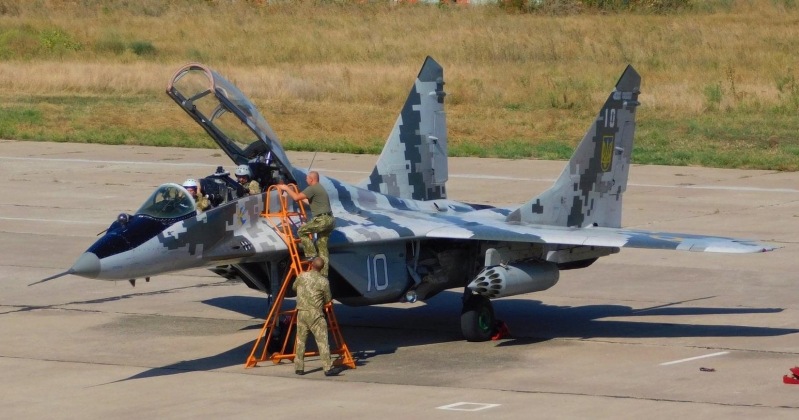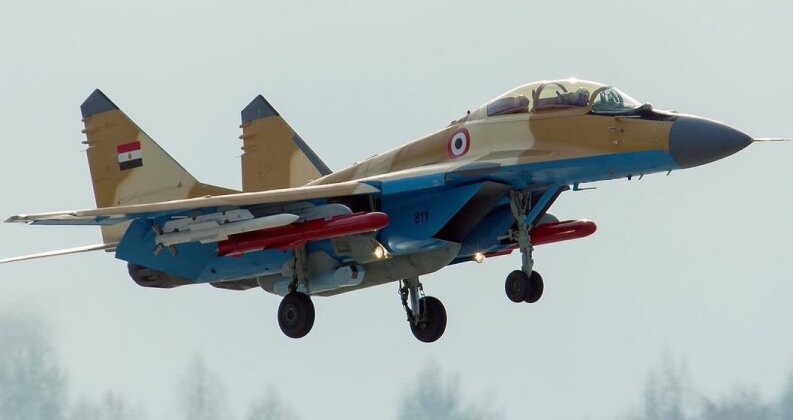October 6 2022 marks 45 years since the first flight of one of the most iconic fighters of the Soviet Air Force the MiG-29, an aircraft which has seen intensive use in combat over the past seven months due to the outbreak of war between Russian and Ukraine. The MiG-29 was one of four Soviet fourth generation tactical combat jets developed, and served as a medium weight aircraft intended to be comfortably able to outperform adversaries such as the F-16 and F-18 and challenge the U.S. Air Force’s top heavyweight the F-15 Eagle. The fighter revolutionised the limitations of flight performance with its extreme and entirely unrivalled manoeuvrability and climb rate when it joined the Soviet Air Force five years later in 1982, and complemented this by integrating high off boresight capable R-73 air to air missiles which were found in testing to provide an overwhelming advantage over all Western aircraft at visual ranges. The missiles allowed aircraft to engage targets without pointing their noses at them, were cued by a pilot’s helmet mounted sights. This particularly revolutionary feature was quickly copied by Western air forces after the first MiG-29s were acquired and studied through a reunified German Air Force in the 1990s, and although a standard feature for the new American F-35 and for modernised variants of Cold War era F-15s and F-16s has yet to be integrated onto its F-22s.

Another particularly notable feature about the MiG-29 was its ability to deploy from short or makeshift runways, which made it an ideal frontline fighter for deployments to Eastern Europe facing NATO forces there. The result was that many Warsaw Pact states which have since been integrated into NATO deploy the aircraft, which also form the backbone of the Ukrainian Air Force. While attacks on Ukrainian airfields and strained supplies have left the country struggling to operate its heavyweight Su-27 air superiority fighters and Su-24M strike fighters, the MiG-29 has been considered ideal for such situations and is far more difficult to ground due to its much more modest runway and maintenance needs. Supplies of parts and possibly in the near future of complete MiG-29 airframes from European NATO members has also been key to keeping the Ukrainian MiG-29 fleet in the air. Nevertheless the fact that Ukraine’s fleet has seen negligible upgrades since the 1980s has left it almost entirely obsolete to counter the Russian Air Force, with Ukrainian claims of a ‘Ghost of Kiev’ ace MiG-29 pilot shooting down multiple Russian fighters having been debunked and admitted as a pure fabrication. The possibility of Ukraine acquiring more modern MiG-29s, possibly through Egypt which fields models with 21st century avionics and weapons and entirely new airframe materials and engines, has been raised by U.S. officials but remains highly unlikely.

The MiG-29 remains in production in Russia today, although it is still far from the oldest fighter that continues to be built with the American F-15 and F-16 also still on production lines. The disintegration of the Warsaw Pact and then the Soviet Union, followed by the near collapse of the Russian economy in the 1990s, resulted in a sharp contraction of the fighter fleet leading the country to favour the heavier and much longer ranged and more capable Su-27. This aircraft had been developed as a heavier higher end counterpart to the MiG-29 and entered service from 1985. Thus the large majority of the Soviet fleet of 800 MiG-29s, which until the end of 1991 was still fast growing, were placed in storage with many later being modernised and exported as a cheaper alternative to newly built models with revised airframe designs. The Su-27’s success, leading it to widely be considered the world’s most capable fighter that comfortably outperformed the F-15 in testing in the U.S., was key to eroding demand for the MiG-29 both in Russia and for export clients.

The most capable MiG-29 variants based on Soviet built airframes include the MiG-29SMT and MiG-29UPG, the latter being a derivative of the former tailored to Indian needs. The most capable variants overall, however, are the MiG-29M and its navalised derivative the MiG-29K which have been exported for service in the Egyptian Air Force, the Algerian Air Force and the Indian Navy. Aside from entirely new avionics these use recognisably very different airframe designs from the originals, benefit from much lower maintenance needs, and have capabilities considered overwhelmingly superior to Cold War era variants in all aspects of performance. Manoeuvrability is the only exception and remains largely unchanged, although it is still a field in which fighter has very few rivals. While the Russian Navy does field the MiG-29K, it acquired the aircraft only because Indian orders financed the opening of production lines and no similar financing was possible for a modern navalised Su-27 derivative. The Russian Air Force itself has not acquired any MiG-29Ms – despite Ukrainian claims to have shot them down.
The result has been that MiG-29s in Russian service tend to be deployed to the lowest priority units far from potential hotspots, leaving Su-27 derivatives such as the Su-34 and Su-35 to do battle over Ukraine while the Ukrainian Air Force, struggling to operate its Su-27s, is expected to continue to rely on the MiG-29. In Russia itself, production lines and modernisation projects for surplus Soviet built airframes are both expected to remain open to meet foreign demand, while the MiG-29M derived MiG-35 has also begun to be offered for export. The development of a direct successor, the fifth generation Checkmate stealth fighter, could result in an end to MiG-29 production close to 2030 should the program materialise in a viable aircraft with similar production and operational costs.
